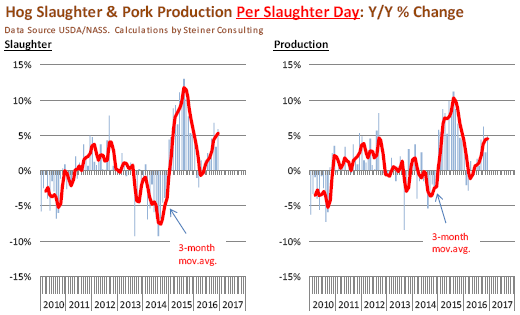



CME: Hog Slaughter in February Down 0.6%
US - USDA issued its monthly production statistics for beef and pork, reports Steiner Consulting Group, DLR Division, Inc.The numbers give us one more piece of data to build the demand picture for red meat in February. It is always important to look at these supply numbers in the broader context of supply flows through the economy rather than as individual data points.
Also important is to recognize that calendar differences often will tend to skew the numbers so one should look past the headline and understand what was the true availability in the domestic market. Below are some of the highlights and implications for pork.
Hog slaughter in February was 9.370 million head, 0.6 per cent lower than a year ago. Average daily slaughter, however, was 468,515, 4.4 per cent higher than the previous year.
One thing to note about the daily slaughter is that it also includes Saturday slaughter so it will not match with the actual week day slaughter numbers you will see from USDA. But this is still a useful measure when adjusting for the number of marketing days.

Sow slaughter in February was 233,100 head, 1 per cent less than last year but adjusting for the slaughter days available sow slaughter was up 3.9 per cent. The pace of sow slaughter has increased in the last six months but a larger breeding herd also implies more cull sows available and current pace of sow slaughter does not suggest contraction in our view.
Pork production in February was down 0.7 per cent from a year ago but it was up 4.3 per cent on an average daily basis. Our estimate is that pork exports in February were about 16 per cent higher than last year. If this number is correct, it would imply a net reduction of about 64 million pounds from domestic pork supplies.
So when adjusting for both the one less slaughter day and population growth, per capita pork disappearance in February was likely down 3 per cent year-on-year, which helps explain the robust pork cutout values.








